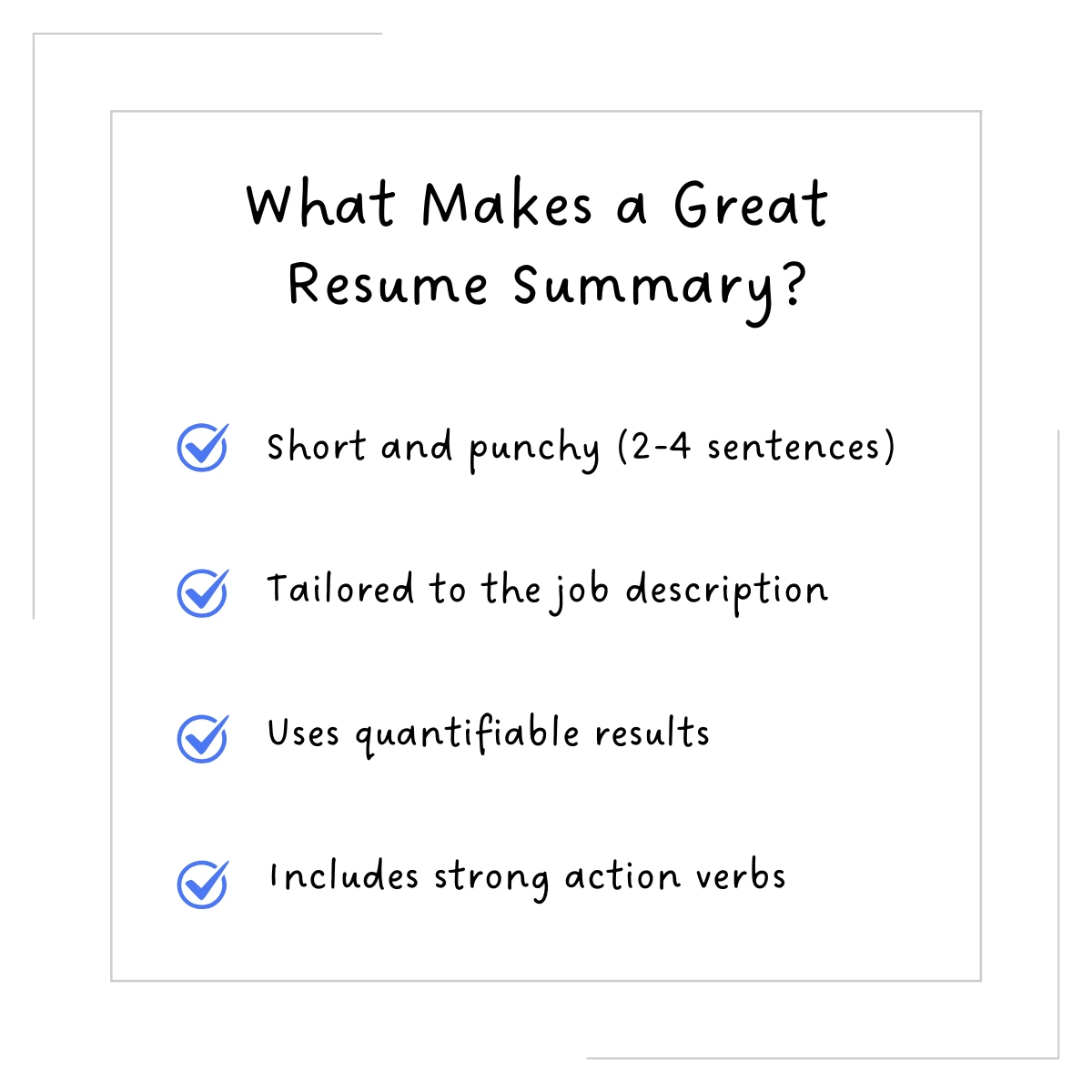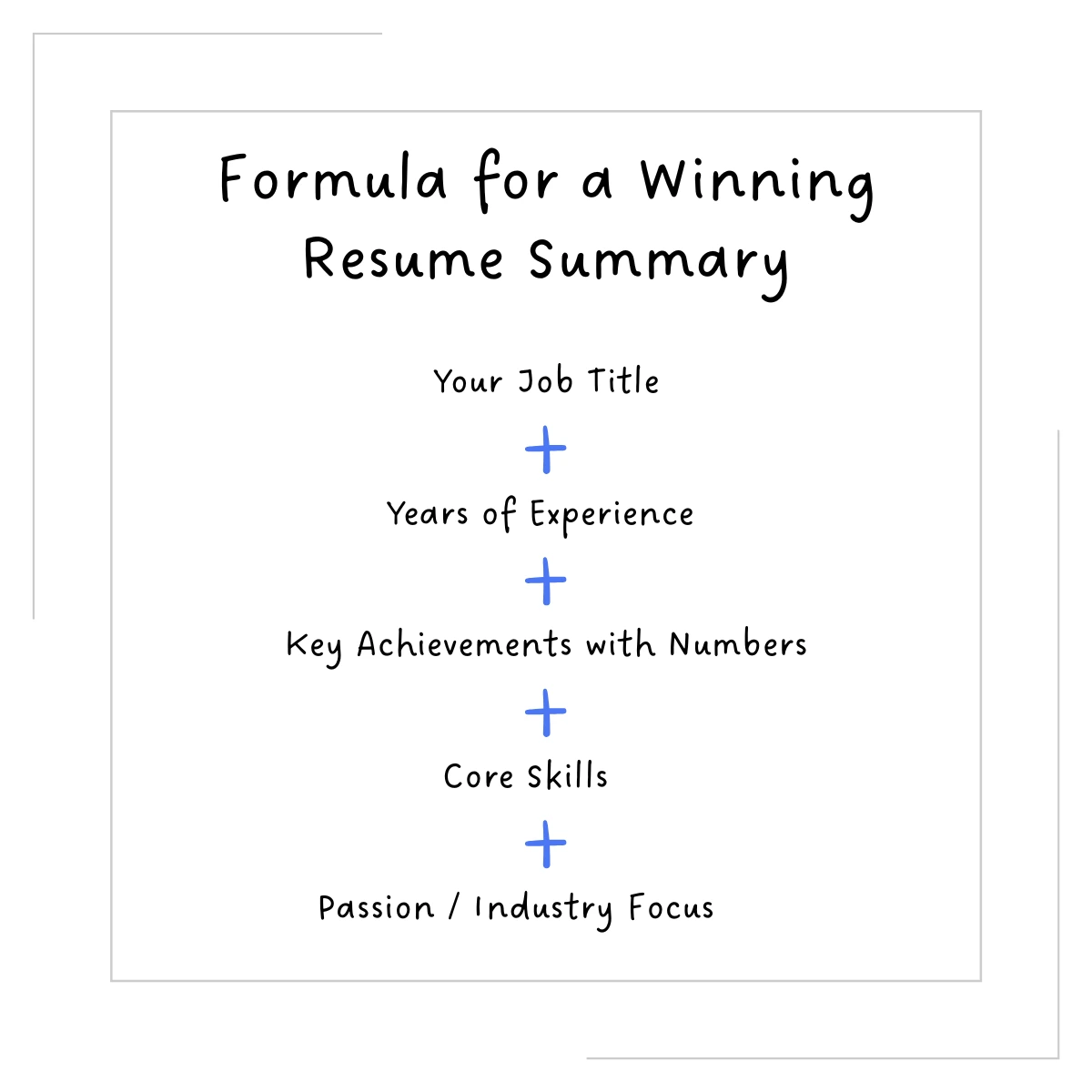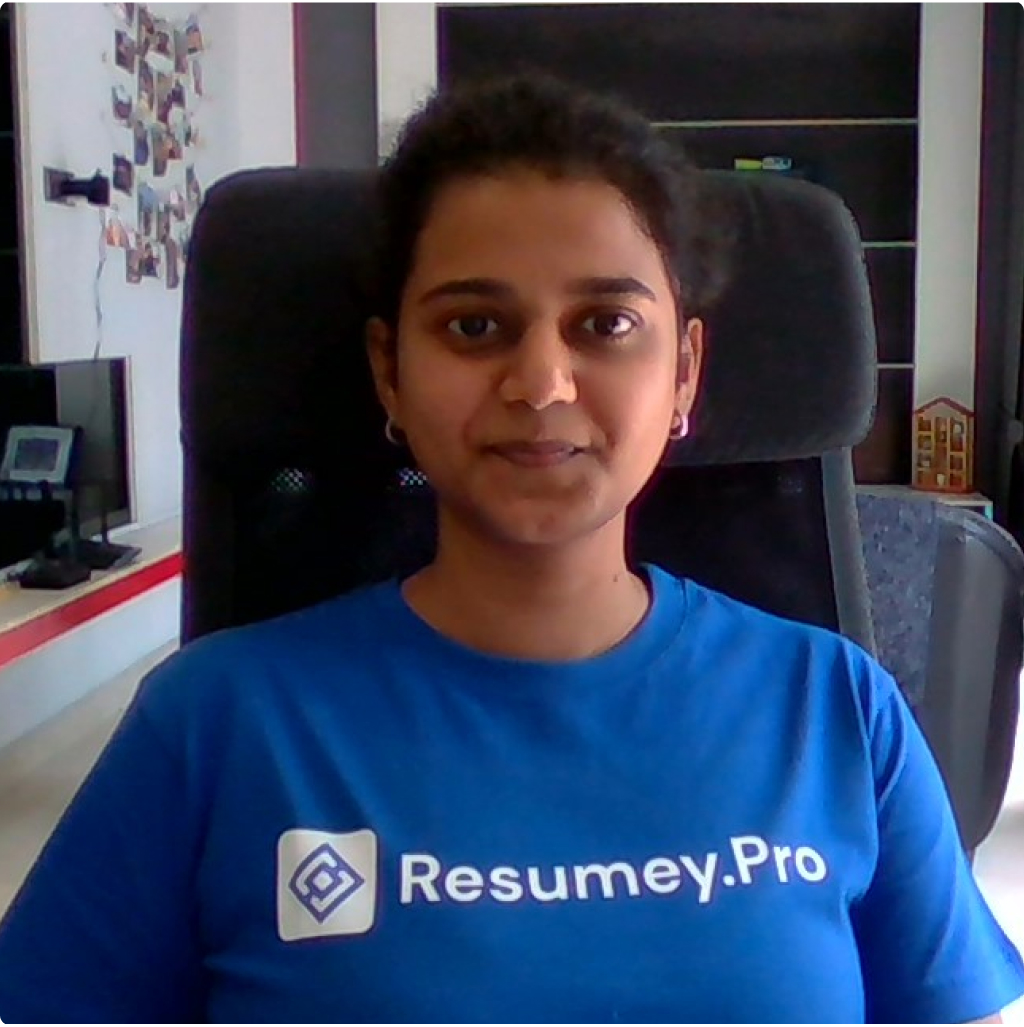Your resume summary is the key to landing interviews
Recruiters don’t 'read' resumes. They scan. And fast, like six seconds fast. If your resume doesn’t hook them immediately, it’s game over. That’s where your resume summary comes in.
Here's an ultimate guide to writing excellent resume summaries that also act as an about me section on resume.
Resume summary vs. objective: which one do you need?
There was a time when resume objectives were all the rage. You’d see something like:
“Seeking a challenging position in a dynamic organization where I can leverage my skills and grow professionally.”
Sounds fancy, but it says nothing. No recruiter reads that and thinks, “Wow, this is the one!”
Instead, they prefer a resume summary. A punchy, to-the-point highlight of who you are, what you bring to the table, and why they should care.
Here’s the difference:
- Resume Objective: “Here’s what I want.” (Meh.)
- Resume Summary: “Here’s what I can do for you.” (Bingo.) Unless you're fresh out of school or making a total career pivot, ditch the objective. A well-crafted resume summary statement instantly tells recruiters, “Hey, I’m exactly what you’re looking for.”
And that’s exactly what we’re going to help you craft. Keep reading.
What makes the best resume summary?
So what exactly makes a resume summary effective? It’s not just a few sentences thrown together at the top of your resume. It’s a strategic highlight reel to instantly communicate why you’re the right fit for the job.
Here’s what separates a good resume summary from a forgettable one:
Keep it short (like, really short)
So how long should a resume summary be?
Recruiters don’t need your life story. They need a digestible snapshot of your core competencies, achievements, and value proposition. Two to four sentences is the sweet spot.
Anything longer, and you risk losing their attention.
❌ “I am a results-driven, highly motivated professional with extensive experience in multiple industries, including marketing, sales, and customer relations. I am looking for an opportunity to leverage my diverse skills and contribute to an organization’s success.”
✅ “Marketing specialist with 5+ years of experience driving customer engagement. Increased conversion rates by 30% and led a rebranding initiative that boosted sales by $500K.”
Tailor it
Your summary should be as specific as possible to the job you’re applying for. That means using:
- Industry keywords (to get past the Applicant Tracking System)
- Relevant skills (not a laundry list, just the big ones)
- Words straight from the job description (they’re literally telling you what they want. Use it!)
Applying for a sales role? Mention revenue growth, customer acquisition, and negotiation skills. Targeting a UX design job? Focus on user research, wireframing, and design thinking. Switching careers? Highlight transferable skills that bridge your past experience with the new field.
Show, don’t tell. Use power verbs and quantifiable results
Nobody believes “hardworking” or “results-driven” anymore. Instead of saying you’re “great at sales,” say:
“Generated $2M+ in revenue and exceeded sales targets by 30% in 2023.”
Use numbers because they add credibility. If you increased efficiency, boosted sales, or led a project, quantify it.
Compare these:
❌ “Experienced project manager skilled in team leadership and process improvement.” (Meh.)
✅ “Project manager who reduced turnaround time by 40% and led cross-functional teams on projects worth $5M+.” (Much better!)
Make it recruiter-proof
A recruiter should be able to skim your summary in three seconds and know:
- Who you are (your job title or area of expertise)
- What you’re great at (main skills or experience highlights)
- Why they should care (key achievements or value proposition)
If it takes longer than that, it's time to trim the fat.
 A Resume Summary Checklist
A Resume Summary Checklist
Best resume summary examples (based on career stage & role)
Okay, enough theory. Let’s get into real examples.
Resume summary example for students (entry-level, no experience)
When you have little to no work experience, your skills, education, and potential are your selling points.
❌ What NOT to do:
“Recent graduate seeking an entry-level role in marketing. Hardworking and eager to learn.” (Translation: “I exist and need a job.” Not helpful.)
✅ What to do instead:
“Recent marketing graduate with strong analytical and creative skills. Managed social media for a university event, increasing engagement by 50%. Proficient in Google Analytics, content creation, and market research. Excited to bring data-driven insights and creativity to a dynamic marketing team.”
Why this works:
-
Focuses on skills & achievements instead of just saying “I need a job”
-
Shows initiative (managing social media for a university event? That counts!)
-
Uses keywords from the field (Google Analytics, market research, engagement)
Resume summary example for career changers
Switching careers? The trick is to highlight transferable skills—what you’ve done that makes you valuable in the new field.
❌ What NOT to do:
“Experienced teacher looking to transition into HR. Passionate about helping people.” (Okay, but… why should an employer take a chance on you?)
✅ What to do instead:
“Former educator transitioning into HR, bringing 7+ years of experience in training, conflict resolution, and team leadership. Skilled at coaching, communication, and creating engaging learning experiences. Eager to apply a people-first mindset to talent development and employee engagement.”
Why this works:
- Translates teaching experience into HR skills (training = talent development, handling students = conflict resolution)
- Uses industry-relevant words (talent development, employee engagement)
- Feels intentional and confident, not like a desperate career switch
Resume Summary Example for Backend Engineers (Mid-Career)
Good backend engineers don’t just write code. They fix bottlenecks, cut costs, and build things that don’t crash. If your resume summary doesn’t say that, rewrite it.
❌ What NOT to do:
"Experienced backend engineer proficient in various programming languages. Passionate about building robust systems and always eager to improve my skills."
That says a lot without saying anything.
✅ What to do instead:
"Backend engineer with 7+ years of experience making systems faster, cheaper, and more reliable. Led the migration from a monolith to microservices, cutting deployment time in half and slashing server costs by 30%. Built and optimized APIs handling millions of requests per day. Skilled in Python, Node.js, Golang, PostgreSQL, and AWS. Knows how to scale things up without breaking everything."
Why this works:
- It cuts the fluff—no generic buzzwords, just results.
- It’s specific—clear numbers, real impact.
- It sounds human—not like it came from a resume template.
Resume Summary Example for Sales Professionals
Sales roles are all about numbers and impact—so your summary should reflect that.
❌ What NOT to do:
“Experienced sales professional with a passion for closing deals and building relationships.” (Boring. No numbers, no specifics, no impact.)
✅ What to do instead:
“Results-driven sales executive with 5+ years of experience exceeding targets. Consistently ranked in the top 10% of sales reps nationwide. Increased revenue by 30% YoY through strategic prospecting and relationship building. Expert in B2B sales, CRM software, and contract negotiation.”
Why this works:
- Numbers! (5+ years, top 10%, 30% revenue increase)
- Shows a track record of success, not just a generic “I like sales” statement
- Uses sales buzzwords (prospecting, CRM, negotiation)
Resume summary example for senior-level professionals
If you’re at the top of your game, your summary should scream leadership and impact.
❌ What NOT to do:
“Seasoned project manager with years of experience in leading teams and managing budgets.” (This tells me nothing. How big were the teams? What kind of budgets? What did you actually achieve?)
✅ What to do instead:
“Strategic project manager with 12+ years of experience leading cross-functional teams on multimillion-dollar projects. Expertise in Agile methodologies, risk management, and stakeholder engagement. Spearheaded a $5M digital transformation initiative, reducing operational costs by 20%.”
Why this works:
- Specific leadership experience (cross-functional teams, multimillion-dollar projects)
- Uses industry language (Agile, risk management, stakeholder engagement)
- Shows big wins ($5M initiative, 20% cost reduction)
Bonus: a universal formula for writing a winning resume summary (step-by-step guide)
Still unsure how to write yours? Here’s a simple formula:
[Your job title] with [X years of experience] in [industry or key skills]. Proven track record of [achievement with numbers]. Skilled in [3-4 key skills], with expertise in [specific tools or methodologies]. Driven to [achieve a specific outcome relevant to the job].
 A Simple Resume Summary Formula
A Simple Resume Summary Formula
Example: “Software Engineer with 5+ years of experience in full-stack development. Spearheaded a major system overhaul that improved load times by 40%. Skilled in JavaScript, React, and cloud computing. Driven to build scalable, high-performance applications.”
A great resume summary follows a clear, straightforward process. This is not about fluff. This is about creating a resume summary that grabs attention and makes the recruiter think, “I need to meet this person.”
Step 1: Start with Your Job Title and Experience
The first thing a recruiter looks for is who you are and what you do. Be clear. Start by stating your job title or career focus right off the bat.
- “Senior Data Scientist”
- “Marketing Manager”
- “Software Engineer with 5+ years experience in Python and JavaScript”
Step 2: Add Your Key Achievements (The Impact)
This is where you tell them why they should care. You don’t want to just list generic duties. You want to show your impact. Remember those numbers we talked about earlier? Use them here.
For example:
- “Increased sales by 30% in one quarter.”
- “Reduced customer churn by 20% through proactive engagement.”
- “Built a system that decreased server downtime by 50%.”
Step 3: Mention Your Core Skills (Tailored to the Job)
Now that you’ve told them what you’ve done, let them know how you did it. This is where you mention core skills and tools that set you apart. But be strategic. Tailor this part to the job description. If the job asks for experience with certain technologies or tools, don’t shy away from mentioning them. This is your chance to weave in the keywords that will pass the Applicant Tracking System (ATS) test.
For example:
- “Skilled in SQL, Python, and machine learning algorithms.”
- “Experienced in Agile, Scrum, and project management tools like Asana and Jira.”
Don’t just mention what you’re good at. Tie it back to how those skills helped you deliver results.
Step 4: Highlight Soft Skills (Only If They’re Relevant)
Yes, we all know that “team player” and “hardworking” are buzzwords. But here’s the thing: some soft skills do matter—if you can back them up with a real-life example.
- “Excellent communicator with experience in client presentations and team collaboration.”
- “Strong leadership skills, having managed a team of 10+ people across multiple projects.”
These aren’t empty claims. You’re showing that you’ve got the soft skills that complement your technical abilities. But don’t overdo it. Focus on the soft skills that actually matter for the role.
Step 5: Add a Personal Touch (Optional, But Powerful)
Finally, sprinkle in a bit of personality. Your resume summary is not a dry list of credentials. It’s also a chance to show that you’re human.
- “Passionate about driving business growth through innovative strategies and creative problem-solving.”
- “Excited to apply my cloud engineering expertise to build scalable systems that drive efficiency.”
A personal touch doesn’t mean oversharing or getting too philosophical—it’s just a small line that shows your motivation and enthusiasm for the role.
Step 6: Customize for Every Job
The final, but crucial step: tailor your resume summary for each job you apply to. Look at the job description and make sure you’re mentioning the skills and experience that are most important to that specific role. Not every job will require the same things, so make sure your summary speaks directly to each opportunity.
Step 7: Edit, Edit, Edit
And then edit some more. It’s time to read through your summary with fresh eyes and ask, “Does this reflect my best work? Could this be clearer? Am I using words that pack a punch?”
If you feel any fluff, trim it. If anything is unclear, rewrite it. And, of course, proofread for grammar and spelling errors. A typo in your summary is like walking into an interview with your fly open—just don’t do it.
The takeaway: resume summary = your golden ticket
A resume summary is not something you slap together in five minutes. It’s your personal branding statement in a few short sentences. And you need to treat it with that kind of care.
If you want your resume to stand out, you need a killer summary. It’s your chance to quickly show the recruiter why you’re the perfect fit. So take your time with it. Follow the steps, focus on results, and make sure every word counts.
And most importantly, keep in mind: This isn’t just about getting a job—it’s about getting the right job. The one where you’ll thrive. The one where you’ll make a real impact. And with a killer resume summary? That job is within reach.
Ready to Craft Your Perfect Resume Summary?
Get started now by using our powerful Markdown editor on Resumey.Pro. It’s fast, easy, and designed to help you create an eye-catching resume summary that gets results!
